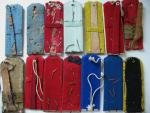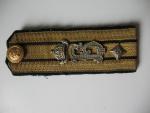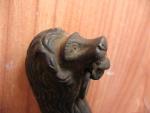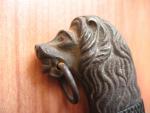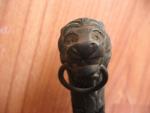-
Posts
1,149 -
Joined
-
Last visited
-
Days Won
1
Content Type
Profiles
Forums
Blogs
Gallery
Events
Store
Everything posted by Theodor
-

Bulgaria Bulgarian Ww2 Shoulder Boards
Theodor replied to hunyadi's topic in Central & Eastern European States
The Police is blue, like the Doctor boards. But I do not know about the gendarmerie. And BTW there were two of them - Gendarmerie in the Army, established in the beginning of the 20 century and Gendarmerie in the Police, established on 19 February 1944, to fight the partisan plague. -

Bulgaria Bulgarian Ww2 Shoulder Boards
Theodor replied to hunyadi's topic in Central & Eastern European States
There are some more types, which I do not have to show. For example, border troops - bright green color. Or horse-tug mountain artillery - looks like ordinary combat board for the infantry, but has the zigzag element of the Cavalry. http://gmic.co.uk/uploads/monthly_08_2009/post-494-125057958458.jpgAnd here are the back sides of the boards, to better show the colors: -

Bulgaria Bulgarian Ww2 Shoulder Boards
Theodor replied to hunyadi's topic in Central & Eastern European States
-

Bulgaria Bulgarian Ww2 Shoulder Boards
Theodor replied to hunyadi's topic in Central & Eastern European States
I hadn't noticed your question. I don't have a color plate or scheme, but can show you some actual boards that show the colors. Here you are: Upper row, left to right: 1. Air Force - sky blue color of the base piping, same color on the rank stripes on the face of the board /the rank stripes are faded here/. This board has silver color face metal threading. There was gold color, too. 2. AAA - air force blue base piping, but red rank stripe on the metal threading face of the board 3. Engineer 4. Labour officer. there was some kind of distinction - Labour Officers and Officers of the Labour Duty. One of these had the boards on the photo, the other had similar, but more going to bright green. 5. Cavalry 6. Looks like cavalry, but yellow color - I believe it is the color of the tank unit. 7. Military of H.M. School cadet Lower row, left to right: 1. NCO combat uniform board 2. Infantry and artillery parade uniform board /infantry had lion on the button, the artillery had cannons/. 3. Infantry and artillery combat uniform board 4. Signals officer board 5. Doctor 6. Again Doctor. There were 2 kinds of emblems - glass with 2 snakes and wreath and glass with snakes only. One designated human doctor, the other - veterinary. Don't remember which was what. 7. Tank men board. Of course, I may have made some mistake, all rights /for mistakes/ reserved :whistle: -

Bulgaria A Bulgarian Non Fighter !
Theodor replied to christerd's topic in Central & Eastern European States
Very nice photo indeed :cheers: -
Ministry of communications, I believe the stamp is similar to the Horn under the name on the document. Probably without the lion though? Can't see it clear, but looks like a horn with a small star over it?
-
I still donot see a picture :blush:
-

Blind german soldier with decorations
Theodor replied to Robert Noss's topic in State, Civil Awards & Decorations
Although the ribbon looks super-long sized, it sure looks like this order. -

Bulgaria Colonel Todor Denchev Dechev Group
Theodor replied to Stogieman's topic in Central & Eastern European States
The rank is Rednik. So he was just an ordinary soldier in the WW2. It looks like /probably shortly postwar/ he pursued military career and became an officer in 1951, hence the 10 years in 1961 and the 15 years in 1966. Both medals point the year 1951. Why no 20 years medal? Who knows... Maybe just missing from the group. Or maybe some scenario, like he quit after 15 - 16 years and was called back at some later point, missing the moment for a 20 years medal? Please show the rest, the other awards and the documents may give some idea. BTW his name is Todor Denchev Dechev. On the 1985 document the second name is wrong /I believe that the 1985 is the document with wrong name, because that Dochkov is a name very unlikely, unheard so far by me, while Denchev is popular/. -

Bulgaria Timev Document & Medal Group
Theodor replied to Stogieman's topic in Central & Eastern European States
It is difficult to say for sure. This line in the booklet says: OT GR /S/ which is short of OT GRAD/SELO. And this means FROM TOWN / VILLAGE........ and the name must be written. Sometimes the wrong alternative /town or village/ is dashed with the pen. Anyway, this line is for his town or village. And instead of that, they just wrote CC of BKP. What i am trying to say is, the readily printed title of this line has no connection to what they have actually written. The way it is written, simply CC of BKP, it can be a member of the Committee, or candidate-member, or probably just working something for the Committee, indeed. I see no problems for him to be a candidate-member or even a member of the CC. Unfortunately I do not know where to find complete list of the CC members. I found lists of the Politbureau of the CC, but the Politbureau was just a small part, a small group elected by the whole CC. Managed to find only one list of CC members, from 1954. And it shows 65 members, plus 32 candidate-members. Quite a bunch! As for his age, at the time of the first entry about the CC, he was 38. I think he could be at least a candidate-member. Of course no way to be sure. Maybe just working for the CC system. If I knew where to find lists with the members! -

Bulgaria Timev Document & Medal Group
Theodor replied to Stogieman's topic in Central & Eastern European States
Born in Sofia, does not speak any foreign languages, graduated the Law Faculty of the Sofia University in 1957. Not marries /at least at the time of the entry/. In the army he was in the infantry, Mladshi Leitenant. Later, as a Reserve, through the decades he was promoted to Leitenant and Starshi Leitenant. So he only spent a couple of years in the army, the usual term, he was not a high rank and received his medals probably because of a high party position. The party book is the usual BKP membership card before 1989. The red card is the Party membership document from 1990 and on. I believe it is not a temporary thing, but the real BSP membership document. After 1989 the BKP renamed it to BSP - from Communist to Socialist party. In fact, the Socialist party pretended it is something new, a modern socialist party and not the old Communist party. But see the miracle - the man is member of the new Socialist party since....... 1961 :speechless: I have seen several of these documents and it is always like this - the BSP is established in 1990, but its members joined in in 1955, 1973, 1961.... I do not know whether the BSP still uses the same red cards today, but I have seen no other membership cards of it. BTW they may have quit printing blank cards - with their criminal and anti-Bulgarian current government, I doubt they had any new member for a while :rolleyes: -

Bulgaria Timev Document & Medal Group
Theodor replied to Stogieman's topic in Central & Eastern European States
These are stamps for address change - one Military District writes him off and another district puts him on the list. He changed his address a few times. -

Bulgaria Timev Document & Medal Group
Theodor replied to Stogieman's topic in Central & Eastern European States
Rick, it's a Doctorate. Copied from the Soviet system. A little post-graduate work, then a short theatre - public defense of a Dissertation /written by the Candidate or by someone else :rolleyes: / and that's it. Of course the main filter was not knowledge/abilities, but political. BTW that man Timev was a member of the Central Committee of the Communist Party, probably that's the reason he got such various awards. -

Bulgaria Timev Document & Medal Group
Theodor replied to Stogieman's topic in Central & Eastern European States
I think it is one and the same person. The first name exists in both ways - Evtim and Eftim /it is an old name, nowadays almost unused, but I have two neighbors with that name and have no idea what letter is used in their names actually!/. Both ways sound the same, so such a mistake is very normal. The mistake in the second name is possible, too. Sometimes people change the letter like that... especially not very educated people. Errors, indeed, but still very possible and normal in my opinion, it's the same guy. -

Bulgaria Bulgarian Ministry of Interior Awards
Theodor replied to Stogieman's topic in Central & Eastern European States
It's 30 Years Border Military Base. Sounds like a badge dedicated to the 30 years of some specific base at the border. But extraordinary, no number or anything pointing to which base. -
Pocheten*... Honoured... nice one :cheers: __________ * the letter E always sounds like in BED, not like any in EVEN. It is always a clear loud E like in BED, RED, S*X and etc :cheers:
-

Bulgaria Small Group with a translation question
Theodor replied to christerd's topic in Central & Eastern European States
It's Tzankova. And indeed she is awarded for her 80th birthday in 1988 -

Bulgaria Bulgarian Army Driver's Badge.
Theodor replied to leigh kitchen's topic in Central & Eastern European States
It's a military driver's badge, but IMO this one is shortly postwar. The wartime ones have a crown. Of course, very often the crowns were removed at the end of the war, but this badge does not have even a hole for the crown. So, I think it is shortly postwar. Still this is good, because the badge looks genuine to me. Lots of unfinished ones have been found somewhere years ago and were better or worse finished and flooded the market, but from what I see here, this one looks good. -
It's a dress bayonet, can not be put on a weapon. So it's not really a bayonet /as the thread is for bayonets/, but hope to fit here for its rarity :cheers:
-
Last, two types of bayonets for the US-made Peabody-Martini for the Turkish army. /the production of the Ottoman contract Peabody Martini in the USA was a whole saga, ending with the bankrupt of the manufacturing company, but that's another story /
-
This looks like a ruined French Gras bayonet, but in fact it is neither Gras, nor French. It is a Steyr made bayonet for the Romanian Peabody-Martini /also made by Steyr/
-
1-2 more bayonets. Not super rarity, but uncommon. First, an ordinary Mannlicher M95. However, post-WW1 in Yugoslavia all markings were removed and a Yugo marking applied. These bayonets were used with uncommon weapon - M95M. Mannlicher 95, converted in Yugoslavia for Mauser rounds.
-
No, it did not have stones. Know 2-3 in local collections, never had glass/stone eyes. These were in fact more sort of combat bayonets, than parade bayonets. Olive painted scabbard, ordinary dark leather frog, combat type dark leather tassel /missing from mine/, wooden grips instead of bakelite or bone. The blade and guard are chromed, but I think the lion head was just iron. I have not yet found this bayonet on period photos! There is no doubt it was period, mine came directly from the "luggage" left from an officer from the beginning of the 20th century - WW1 period. He was neither a sergeant, nor a general, but a military administrative officer. So, the mystery about these bayonets remains!
-
Yes, indeed, looks like that, but just looks, it is not modified. These bayonets were made by Horster Solingen specially for Bulgaria. Here are some clear photos


